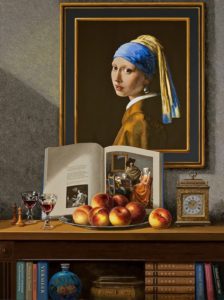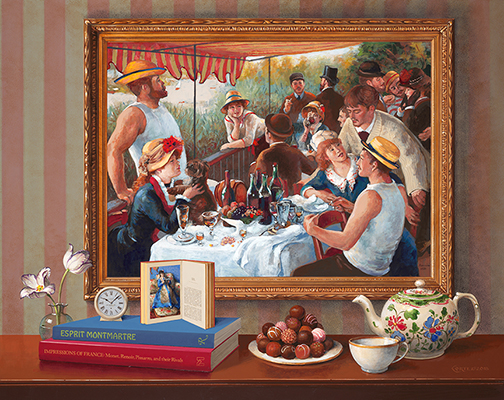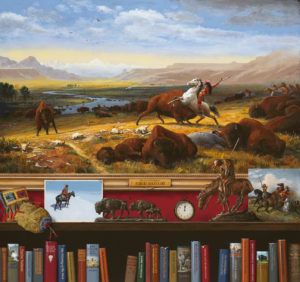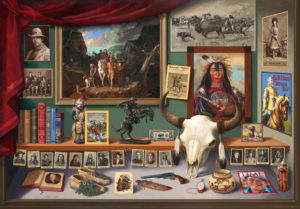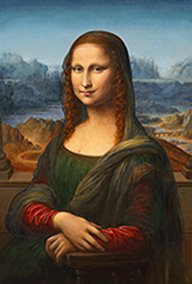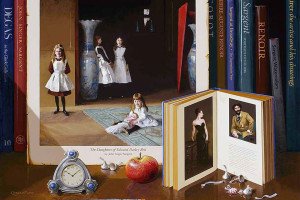Press Room
New Jenness Cortez Art Appreciation YouTube Channel
“Demystifying the Masters”
AVERILL PARK, NY (PRWEB) July 21, 2020 — Internationally acclaimed contemporary realism artist Jenness Cortez announced the launching of her new YouTube channel dedicated to “Demystifying the Masters.” All the Cortez video episodes are entertaining investigations into the minds, hearts, intentions, and techniques of gifted artists, and into the intriguing details of times and places that influenced their work.
In each video episode of “Demystifying the Masters,” Cortez uses one of her own paintings as her starting point. In explaining her own creation, she shares insights into the hows and whys and little-known stories about some of the world’s most admired masters like Winslow Homer, John Singer Sargent, Frederic Remington, Norman Rockwell, Andy Warhol, Johannes Vermeer, Vincent Van Gogh, Jan van Eyck, Pierre-August Renoir, Camille Pissarro and Claude Monet.
But why does the world need art? Why do our communities, our families and we, ourselves, need art? Why–considering all the uncertainty and trouble in the world–does art even matter? Artist Jenness Cortez offers her explanation this way: “Learning to really see art can mean learning to see the whole world, every day, in new and richer ways. It doesn’t take any special preparation to start the process, and the rewards grow as you explore.”
Jenness Cortez begins her own creative process by selecting another artist’s iconic painting to serve as the centerpiece of her original composition. Depending on her response to that chosen painting, the artist who created it, and the time and culture that gave birth to it, Cortez then becomes author, art director, architect, visual journalist, art historian, curator and pundit as she searches for supportive elements—such as books, photographs and clocks—to assist in telling her story.
Completion of her painting involves thousands of choices, each one determined by her highly perfected intuitive sense of what is needed. Then, when all the elements are in harmony–in service to her vision–the viewer is drawn into the picture. And it is this instantaneous seduction that leads us into exploring the hidden secrets and pleasures awaiting our discovery.
Like the Old Masters she admires, Cortez renders textures of fabric, surfaces of wood, the tactile quality of a piece of fruit, an aged piece of paper, and so on, with convincing realism. In the same way, the famous works portrayed in her compositions are appropriated with deep respect for their creators. In each short episode of “Demystifying the Masters,” Jenness Cortez adds to both the viewer’s understanding and appreciation of famous works by world-respected masters.
New Cortez Exhibition
Pays Homage to Johannes Vermeer and Childe Hassam
AVERILL PARK, NY (PRWEB) February 13, 2019 — A new exhibition by internationally acclaimed painter Jenness Cortez will honor a group of illustrious artists including Johannes Vermeer, Pierre-Auguste Renoir, John Singer Sargent, Childe Hassam and Winslow Homer. On view February 17 through March 8, 2019 at the Harmon-Meek Gallery in Naples, Florida, this one-person show represents the latest installment in the Cortez series of thought-provoking paintings depicting art in art.
Historically, the tradition of “art in art” was most notably employed by such 17th-century Dutch artists as Johannes Vermeer. In her own painting “Alluring,” Cortez pays homage to the genius of Vermeer by incorporating his iconic ”Girl with a Pearl Earring“ into her own original composition. In “Alluring” Cortez continues to reexamine the classic paradox of realism: the painting both as a “window” into an imagined space and as a physical object.
Painting details: “Alluring,” © by Jenness Cortez: acrylic on mahogany panel, 40 by 30 inches; Homage to: Johannes Vermeer (1632-1675) “Girl with a Pearl Earring” 1665, Mauritshuis Museum, The Hague; “The Glass of Wine,” Gemaldegalerie Alte Meister, Dresden; Franz van Mieris (1635-1681); “The Oyster Meal,” Mauritshuis Museum, The Hague; Miniature Queen Anne Clock by Henry Stockar, London c.1705; Chinese cloisonné Moon Flask, Ming dynasty, Jingtai mark (1450-1456), private collection; Chinese export lacquer Tea Chest c. 1840, private collection
A second Cortez painting in the Harmon-Meek exhibition pays homage to American impressionist painter Childe Hassam and U.S. veterans by incorporating Hassam’s “Rainy Day, Fifth Avenue 1916” into her own stately work entitled, “Centennial.”
Painting details: “Centennial” © by Jenness Cortez: acrylic on mahogany panel, 30 by 24 inches; Homage to: Childe Hassam (1859-1935) “Rainy Day, Fifth Avenue 1916” Collection of Princeton University, Princeton, New Jersey; Silver clock c.1900 by Archibald Knox for Liberty, Private collection;
100 year old Juniper Bonsai, Collection of Nippon Bonsai Association, Tokyo, Japan; “Uncle Sam” by James Montgomery Flagg, Private collection; Photo of New York City skyline, 1949, Photographer unknown; Photograph of reproduction of the Tri-wing Fokker piloted by The Red Baron, Photographer unknown; Portrait of “Major General the Earl of Athlong” by Sir Alfred Munnings, Collection of Windsor Castle; “Allies’ Day, May 1917” by Childe Hassam, Collection of National Gallery of Art, Washington, DC
For centuries artists have been challenging their intellects and skills by paying homage to the painters who preceded them. Today, Jenness Cortez has emerged as the twenty-first century’s most notable exponent of this facet of art history. Her masterful work gives Cortez solid footing in the colorful lineage of artists who have appropriated vintage images and woven them into their own distinctive, recognizable fabric.
Robert Yassin, former Executive Director of the Indianapolis Museum and Palos Verdes Art Center, refers to Cortez as one of the world’s most eloquent and successful visual conversationalists. Yassin says that, “All art is a dialogue . . . In Cortez’s paintings, each work talks to us at many levels, and creates in us a sense of both understanding and wellbeing. This happens because there is nothing arbitrary in Cortez’s paintings. The choice of the painting reproduced, the elements surrounding it, the space the elements occupy, the lighting, the color, everything is carefully selected and orchestrated following a fully articulated plan determined by the artist.” Yassin, who also served as director of Tucson Museum of Art during his illustrious career, freely confides that “the paintings of Jenness Cortez make my heart sing,”
In summarizing her creative process, Cortez explains, “Every painting begins with a vision seen in the artist’s mind. Sometimes the finished piece appears in the mind full-blown, and at other times it is amorphous––yet with some beguiling character that begs to be developed. In either case, between that first inspiration and the finished painting lie hours of research, thousands of choices and, of course, the great joy of painting. The process is organic. Even with a well-conceived composition in place, the painting has a life of its own and the best ones surprise even the artist with twists and turns that outshine the most clever of plans. It’s as if the creative spirit insinuates itself into the work, wanting to serve its own best interest with solutions that far exceed the artist’s original, limited vision.”
Each intricate Cortez creation challenges the viewers’ intellectual curiosity and celebrates the sheer pleasure of beautiful painting. In her latest Harmon-Meek exhibition, Cortez plays author, architect, visual journalist, art historian, curator and pundit to help open our eyes to what we might otherwise have overlooked or taken for granted. Each painting presents a specific theme, mixing straightforward cues and obscure allusions, complemented by references to other artists’ lives and times. By masterfully presenting iconic works of art in unexpected modern settings, Jenness Cortez truly inspires us to see differently––to rediscover, revalue and reintegrate our own intuitive resources into the hurried and often stress-filled culture of modern American.
New Important “Art in Art”
Painting Exhibition by Jenness Cortez
NAPLES, FL (PRWEB) February 7, 2018 — Harmon-Meek Gallery of Naples, Florida, will host a solo exhibition by internationally acclaimed artist Jenness Cortez. On view February 11 through April 9, 2018, Cortez presents the latest installment in her series of thought-provoking paintings depicting iconic images that inspire viewers to rediscover and revalue their own creative potential.
Robert Yassin, former Executive Director of the Indianapolis Museum and Palos Verdes Art Center, refers to Cortez as one of the world’s most eloquent and successful visual conversationalists. Yassin says that, “All art is a dialogue . . . In Cortez’s paintings, each work talks to us at many levels and creates in us a sense of both understanding and wellbeing. This happens because there is nothing arbitrary in Cortez’s paintings. The choice of the painting reproduced, the elements surrounding it, the space the elements occupy, the lighting, the color, everything is carefully selected and orchestrated following a fully articulated plan determined by the artist.” Yassin, who also served as director of Tucson Museums of Art during his illustrious career, freely confides that “the paintings of Jenness Cortez make my heart sing,”
For centuries artists have been challenging their intellects and skills by paying homage to the painters who preceded them. Today, Jenness Cortez has emerged as the twenty-first century’s most notable exponent of this facet of art history. Her masterful work gives Cortez solid footing in the colorful lineage of artists who have appropriated vintage images and woven them into their own distinctive, recognizable fabric.
In her most recent work Cortez continues to reexamine the classic paradox of realism: the painting both as a “window” into an imagined space and as a physical object. In summarizing her creative process, Cortez explains, “Every painting begins with a vision seen in the artist’s mind. Sometimes the finished piece appears in the mind full-blown, and at other times it is amorphous–yet with some beguiling character that begs to be developed. In either case, between that first inspiration and the finished painting lie hours of research, thousands of choices and, of course, the great joy of painting. The process is organic. Even with a well-conceived composition in place, the painting has a life of its own and the best ones surprise even the artist with twists and turns that outshine the most clever of plans. It’s as if the creative spirit insinuates itself into the work, wanting to serve its own best interest with solutions that far exceed the artist’s original, limited vision.”
Each intricate Cortez creation challenges the viewers’ intellectual curiosity and celebrates the sheer pleasure of beautiful painting. In her Harmon-Meek exhibition, Cortez plays author, architect, visual journalist, art historian, curator and pundit to help open our eyes to what we might otherwise have overlooked or taken for granted. Each painting presents a specific theme, mixing straightforward cues and obscure allusions, complemented by references to other artists’ lives and times. In part, this year’s body of work pays homage to George Inness, Frederic Remington, Andy Warhol, Childe Hassam, Norman Rockwell, Salvador Dali, Pierre-Auguste Renoir and Camille Pissarro. By masterfully presenting iconic works of art in unexpected modern settings, Jenness Cortez truly inspires us to see differently–to rediscover, revalue and reintegrate our own intuitive resources into the hurried and often stress-filled culture of modern American.
Cortez “Requiem” Painting
To be Auctioned at the C.M. Russell Museum
AVERILL PARK, NY (PRWEB) March 15, 2016 — The C.M. Russell Museum of Great Falls, Montana, will auction an important painting entitled “Requiem” by internationally acclaimed artist Jenness Cortez at its annual exhibition and sale March 19, 2016. In “Requiem,” Cortez uses Albert Bierstadt’s final great western landscape “The Last of the Buffalo” as her own painting’s focal point to pay homage to the culture of the Native Peoples of the American plains. But to bolster Bierstadt’s tribute to the buffalo and Native American culture, Cortez has added a steam locomotive and train to the painting’s middle ground–intending to emphatically illustrate the force and inevitability of the white man’s conquest of the plains.
In “Requiem,” as in all her paintings, artist Jenness Cortez continues to play the role of author, visual journalist, art historian, curator and pundit to help open our eyes to what we might otherwise have overlooked or taken for granted. To help tell her Native Peoples’ story more completely, she complements Bierstadt’s 1888 masterpiece with other iconic images from Frederic Remington, Charles Russell, James Earle Fraser, John Mix Stanley, Alfred Jacob Miller and George Catlin. Then, to further enrich her visual conversation, Cortez includes 28 books that relate to her message. And two books depicted in the bookcase are of special note: “Black Earth” and “Winnetou.” In “Black Earth,” contemporary Yale historian Timothy Snyder draws eerie parallels between the U. S. government’s policy of Manifest Destiny and the philosophy eventually espoused by the Third Reich of Nazi Germany. Karl May’s spectacularly popular novels, like “Winnetou,” romanticized the American West for millions of German children (among them the young Adolph Hitler) at the turn of the twentieth century. Snyder posits that Hitler, an avowed life-long fan of May’s books, saw in May’s description of U. S. policy the model for conquering territory through the extermination of native peoples.
In this new Cortez painting, the artist continues to reexamine the classic paradox of realism: the painting both as a “window” into an imagined space and as a physical object. In summarizing her creative process, Cortez explains, “Every painting begins with a vision seen in the artist’s mind, and “Requiem” is no exception. Sometimes the finished piece appears in the mind full-blown, and at other times it is amorphous––yet with some beguiling character that begs to be developed. In either case, between that first inspiration and the finished painting lie hours of research, thousands of choices and, of course, the great joy of painting. The process is organic. Even with a well-conceived composition in place, the painting has a life of its own and the best ones surprise even the artist with twists and turns that outshine the most clever of plans. It’s as if the creative spirit insinuates itself into the work, wanting to serve its own best interest with solutions that far exceed the artist’s original, limited vision.”
For centuries artists have been challenging their intellects and skills by paying homage to the painters who preceded them. Today, Jenness Cortez has emerged as the twenty-first century’s most notable exponent of this facet of art history. Her masterful work, now expanded to include the genre of Western art, gives Cortez solid footing in the colorful lineage of artists who have appropriated vintage images and woven them into their own distinctive, recognizable fabric.
By continuing to masterfully present iconic works in unexpected modern settings, Jenness Cortez truly inspires us to see differently––to rediscover, revalue and reintegrate our own intuitive resources into the hurried regimen of modern American life.
Biographical Notes:
Jenness Cortez was born in 1944 in Frankfort, Indiana. She received her B.F.A. from the Herron School of Art in Indianapolis, apprenticed privately with noted Dutch painter Antonius Raemaekers and later studied with Arnold Blanch at the Art Students League of New York. Her work is in numerous public and private collections including those of Presidents Ronald Reagan and Bill Clinton, HM Queen Elizabeth, II and the New York State Museum. Miss Cortez is represented by Jenness Cortez in Averill Park, New York.
Artist Jenness Cortez’s “Window on the West” Painting
To be offered at Coeur d’Alene Art Auction
AVERILL PARK, NY (PRWEB) June 18, 2015 — “Window on the West,” a new painting by acclaimed artist Jenness Cortez will be sold at the annual Coeur d’Alene Art Auction, July 25, 2015 at the Peppermill Resort in Reno, Nevada. In her latest work Cortez documents exactly 200 years of the American West’s history––from 1804 when President Thomas Jefferson dispatched the Lewis and Clark expedition, to 2004 and the passing of the first truly western U. S. president, Ronald Reagan.
For over 25 years the Coeur d’Alene Art Auction has specialized in the finest classical Western and American Art representing past masters and outstanding contemporary artists. According to public records, the Coeur d’Alene Art has profited their clients nearly $240 million in the last decade. According to The Wall Street Journal, “Reno is home to the nation’s biggest and most successful auction of Western art.”
In “Window on the West,” Jenness Cortez continues to reexamine the classic paradox of realism: the painting both as a “window” into an imagined space and as a physical object. Summarizing her creative process, Cortez explains, “Every painting begins with a vision seen in the artist’s mind. Sometimes the finished piece appears in the mind full-blown, and at other times it is amorphous––yet with some beguiling character that begs to be developed. In either case, between that first inspiration and the finished painting lie hours of research, thousands of choices and, of course, the great joy of painting. The process is organic. Even with a well conceived composition in place, the painting has a life of its own and the best ones surprise even the artist with twists and turns that outshine the most clever of plans. It’s as if the creative spirit insinuates itself into the work, wanting to serve its own best interest with solutions that far exceed the artist’s original, limited vision.”
“To be of value,” Cortez says, “the visual conversation initiated by my paintings must have some significant meaning. And that meaning must be communicated clearly and understood by the viewer. In ‘Window on the West,’ I am presenting–for the viewer’s contemplation—images that tell many of the stories that comprise the 200-year history of the American West. In 1801, for example, when Thomas Jefferson became president of the United States, two out of every three Americans lived within fifty miles of the Atlantic Ocean. To the west, France owned the vast, largely unexplored Louisiana Territory where Napoleon hoped to establish an empire in the New World. In 1802 President Jefferson offered to buy the port of New Orleans from France, but Napoleon Bonaparte, strapped for cash to fund his wars, counter-offered to sell the entire Louisiana Territory, 820,000 square miles, for $15 million––an amount which was twice the U. S. federal budget. With a stroke of his pen, Jefferson more than doubled the size of the country. In the press of the times the purchase was called “Jefferson’s Folly.” Today we know Thomas Jefferson’s vision as the birth of the American West.
Like all her other work, this intricate Cortez creation challenges the viewers’ intellectual curiosity and celebrates the sheer pleasure of beautiful painting. In “Window on the West,” Cortez plays author, architect, visual journalist, art historian, curator and pundit to help open our eyes to what we might otherwise have overlooked, forgotten, or taken for granted. By masterfully presenting iconic works of the American West, Jenness Cortez again inspires us to see differently––to rediscover, revalue and reintegrate our own intuitive resources into the hurried regimen of modern American life.
Elements Contained in “Window on the West”
On back wall:
Edward S. Curtis self portrait photogravure 1899;
“Fort Worth Five” front row left to right:
Harry A. Longabaugh (Sundance Kid), Ben Kilpatrick (the Tall Texan), Robert Leroy Parker (Butch Cassidy),
standing: Will Carver and Harvey Logan (Kid Curry), 1900 photograph by John Schwartz, Smithsonian Institution’s National Portrait Gallery;
George Caleb Bingham (1861-1879)
“Daniel Boone Escorting Settlers through the Cumberland Gap” Mildred Lane Kemper Art Museum;
Frederic Remington (1811-1909)
“In from the Night Herd” engraving after Remington drawing, “Harper’s Weekly” October 9, 1886;
“Her Calf” en grisaille, Amon Carter Museum of American Art;
George Catlin (1796-1872)
Blackfoot Chief “Stu-mick-o-súcks (Buffalo Bull’s Back Fat) Head Chief, Blood Tribe”
Smithsonian American Art Museum;
Annie Oakley (Phoebe Ann Mosey) studio portrait;
Col. W.F. Cody, 1908 Buffalo Bill lithograph.
On the shelf:
Albert Bierstadt (1830-1902) “Emigrants Crossing the Plains” The Butler Institute of American Art; Kachina (Paiyatemu), Zuni late 19th century Brooklyn Museum; Frederic Remington (1861-1909) “The Broncho Buster” Bronze Metropolitan Museum; 1901 $10 Legal Tender Bison Note; Early 20th century buffalo skull; Eanger Irving Couse (1866-1936) “The Kachina Painter” private collection; Charles M. Russell (1864- 1926) “Bronc to Breakfast” watercolor National Geographic January 1986, Montana Historical Society.
Carte de visite photographs: Gen. George Armstrong Custer, National Photographic Art Gallery; Sitting Bull,
Hunkpapa Lakota holy man and tribal chief; Calamity Jane (Martha Jane Canary) frontierswoman and scout; James Butler “Wild Bill” Hickok, lawman, gunfighter; Sara Winnemucca, social reformer for Native American rights c.1880; Chief Gall (Pizi) Hunkpapa Sioux 1881 photographed by David F. Barry, National Archives; William S. Hart, silent film actor; Myra Maybelle Shirley Reed (Belle) Starr, outlaw, Oklahoma Historical Society; Frederic Remington at Yale, Dow Studios, Amon Carter Museum of American Art; Lucia Darling, first Montana school teacher 1863, Beaverhead County Museum; Red Cloud, photographed by Charles Milton Bell 1880; Charles M. Russell, Harry Pollard photographer 1919, Brian W. Dippie Collection; Black Elk, Oglala Lakota (Sioux) medicine man; William Penn Adair “Will” Rogers humorist, 19th century photograph; Chief Joseph–Nez Perce photogravure by Edward Curtis early 20th century.
Foreground display:
Rembrandt Peale (1778-1860) Thomas Jefferson, White House Historical Association; Kiowa Moccasins c. 1870, private collection; Norman Rockwell (1894-1978) “Dreams of Long Ago” Saturday Evening Post August 13, 1927; Apache knife and sheath 1870; Colt 1851 Navy Revolver; 1890 pocket watch, American Waltham Watch Company; Acoma Olla (jar) c. 1770 private collection; Time (magazine) Ronald Reagan Commemorative Issue, June 14, 2004; Kachina, Kana-A Hopi c.1880.
Biographical Notes:
Jenness Cortez was born in 1944 in Frankfort, Indiana. She received her B.F.A. from the Herron School of Art in Indianapolis, apprenticed privately with noted Dutch painter Antonius Raemaekers and later studied with Arnold Blanch at the Art Students League of New York. Her work is in numerous public and private collections including those of Presidents Ronald Reagan and Bill Clinton, HM Queen Elizabeth, II and the New York State Museum.
Artist Jenness Cortez is represented by Jenness Cortez in Averill Park, New York and Trailside Galleries in Scottsdale, Arizona and Jackson Hole, Wyoming.
New Jenness Cortez Painting
Depicts Leonardo’s “Mona Lisa” as it Originally Appeared
AVERILL PARK, NY (PRWEB) March 18, 2015 — After a year of scholarly research, internationally acclaimed artist Jenness Cortez announced her completion of a new painting that depicts Leonardo da Vinci’s “Mona Lisa” masterpiece as she believes it appeared at completion in the early 16th century. Commissioned by a private American collector, the Cortez work is said to incorporate several compositional elements from the
recently restored Prado Museum copy.
Having fulfilled her assignment to convey the impression Leonardo’s painting made when it was newly completed, Ms. Cortez immediately distanced her accomplishment from the original work by noting, “The craftswoman in the current project makes no claim to have equaled the great subtleties of the master’s technique. However, my best scholarship, experience, intuition, imagination, passion and skills have gone into producing this conceptual reconstruction. Even though I’ve embraced Leonardo’s ‘obstinate rigor’ throughout this project, I like to think that there was also a little help from the same playful muse that whispered to Leonardo while he worked. I hope this imagined Lisa will be a pleasure to all who view her.”
The challenges to her successful reconstruction of the world’s most iconic Renaissance image were many and varied. According to renowned researchers and conservators, numerous visible changes in the Mona Lisa have occurred over time as the results of one or more of five causes: 1. the darkening and yellowing of varnish, 2. the disappearance of fugitive pigments, 3. natural chemical changes that have altered pigments’ original hues, 4. overzealous cleaning, and 5. movement within the poplar panel (as the wood continually expanded and contracted in response to changes in humidity.)
For an understanding of the science behind these and other factors Cortez closely relied on the findings of the French Center for Museum Research and Restoration (FCMRR) laboratory studies conducted in 2004. Their conclusions, together with historical records, a copy of the Mona Lisa made by a contemporary of Leonardo, and her own experience as a painter, have suggested the following alterations which Cortez has made from the
present day appearance of the painting.
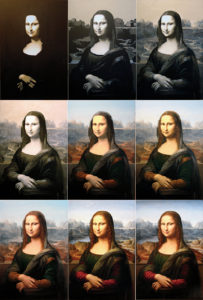 Many areas of the painting have been lightened and brightened to correct 500 years of varnish discoloration that disguises color and value, and obscures details. The FCMRR states that blues, browns and greens have suffered most, so they have been given special attention.
Many areas of the painting have been lightened and brightened to correct 500 years of varnish discoloration that disguises color and value, and obscures details. The FCMRR states that blues, browns and greens have suffered most, so they have been given special attention.
- Slight color changes overall were made in accordance with FCMRR analysis of pigments, with an understanding of how these pigments would have responded to time, light and varnish.
- The surface crackle patterns, which are primarily a result of persistent panel movement that has broken the paint film, have been eliminated.
- Certain details destroyed in early, over-intense cleanings have been reconstructed. For example, in areas of the shadow between the bridge of the nose and the right eye and on the chin, glazes that have obviously been lost have been restored. Cortez believes it is likely that there have also been more subtle losses. Where the top of the bodice meets Lisa’s flesh, Cortez noticed faint paint traces. Their presence convinced her that the delicate
white trim of the bodice, so visible in an Italian Renaissance copy (in the collection of the Prado Museum), does indeed record what Leonardo painted. That recently cleaned and restored copy was made by an anonymous painter during Leonardo’s lifetime and presumably documents the original appearance of the Mona Lisa. - The Prado Museum copy also shows highlights in the eyes, although none appear today in the Louvre painting. On that point Cortez quotes Giorgio Vasari, who wrote the earliest description we have of the Mona Lisa in his 1550 book, “Lives of the Most Eminent Painters, Sculptors and Architects.” Less than 50 years after Leonardo completed the Mona Lisa, Vasari commented that, “The eyes have that lustre and watery sheen which are always seen in life.” Cortez has returned the sparkle to Lisa’s eyes.
- The painting’s monotone appearance today is likely due in part to Leonardo’s extensive use of fugitive, organic pigments in thin glazes. The FCMRR found most of the modeling of the face and hands to now consist of only burnt umber over lead white. However, Vasari refers to the “rosy and tender” nostrils, the “red of the lips,” and the lively skin tones that seemed to be “not colors, but flesh.” Certain reds, (“lakes”) made from the bodies and secretions of insects, were widely used in the Renaissance, but have often lost their color with time. In the Mona Lisa’s case that loss was perhaps accelerated by their use in Leonardo’s fragile glazes, which would have been especially vulnerable to insensitive cleaning.
- The sleeves that now appear as a bronze color may have been glazed with one of those fugitive reds, as the Prado Museum copy suggests, or with another color. Red seems the logical choice to Cortez, although there is no specific mention of it in the FCMRR studies.
- Lisa’s eyebrows (or lack thereof) contribute greatly to her enigmatic expression. Cortez has only slightly enhanced the brows, but we know they were once more visible. Their subtlety impressed Vasari: “The eyebrows, through his having shown the manner in which the hairs spring from the flesh, here more close and here more scanty, and curve according to the pores of the skin, could not be more natural.” Cortez chose not to further speculate on the arch, size and color of the eyebrows, feeling that any misreading on her part would irresponsibly alter the Mona Lisa’s expression, and could seriously misrepresent Leonardo’s intention.
- Lisa’s hair, which today appears to be nearly black, was probably a warm chestnut brown according to sophisticated technology the FCMRR used to approximate the colors as they would have appeared before the varnish blackened with time. The rendering of the hair was suggested by Leonardo’s technique in his two versions of The Madonna of the Rocks. (The lighter color and fine texture of her hair do make scanty eyebrows seem a definite possibility.)
- All over the painting, small details that are now rendered invisible by the old varnish have been painted in accordance with the revelations accomplished by the FCMMR’s innovative imaging techniques.
- Throughout the reconstruction process, Cortez chose to lighten, but not completely abandon the darkest chiaroscuro effects, believing that Leonardo consciously employed them in this painting (as he did in others) to enhance drama and mystery. Although the blackening of varnish has no doubt intensified the darks, Leonardo’s treatise on painting makes it clear how highly he valued the impact of soft, theatrical light and deep shadowing.
Biographical Notes:
Jenness Cortez was born in 1944 in Frankfort, Indiana. She received her B.F.A. from the Herron School of Art in Indianapolis, apprenticed privately with noted Dutch painter Antonius Raemaekers and later studied with Arnold Blanch at the Art Students League of New York. Her work is in numerous public and private collections including those of Presidents Ronald Reagan and Bill Clinton, HM Queen Elizabeth, II and the New York State Museum.
Jenness Cortez in Averill Park, New York exclusively represents Jenness Cortez.
Contact:
Leonard Perlmutter
Jenness Cortez
https://jennesscortez.com
(518) 674-8711
Naples, Fla. (PRWEB ) January 19, 2010 — Following last year’s spectacular, sold-out show, DeBruyne Fine Art will host their ninth solo exhibition by artist Jenness Cortez. “Homage to the Creative Spirit,” on view January 28 through March 31, 2010, presents a captivating selection of Cortez’s most recent contemporary American realism paintings.
For centuries artists have been challenging their intellect and skills by paying homage to the painters who preceded them. In her new work, Jenness Cortez becomes the 21st century’s most notable example of this genre. Her continuing dedication to creating original paintings that incorporate art within art makes her work compelling––both by the virtuosity of her craft and by her astonishing fidelity to a broad range of artistic genres. This masterful work gives Cortez solid footing in the colorful history of artists who have appropriated vintage images and woven them into their own distinctive, recognizable fabric.
The ancient genre of “art in art” flowered throughout the 17th century and became a staple with many of the Dutch masters including Johannes Vermeer. In modern times, Pablo Picasso, Roy Lichtenstein, Andy Warhol, Jasper Johns and Larry Rivers all have acknowledged the inspiration they found in employing the works of artists who came before them.
Jenness Cortez has made references to other works of art the core of her intriguing interiors and still life paintings that explore the definitions of what art is. Through her current show’s visual homage to Mary Cassatt, Leonardo DaVinci, Winslow Homer, Childe Hassam, Claude Monet, Norman Rockwell, John Singer Sargent, Titian, Vincent Van Gogh and Johannes Vermeer, Cortez reexamines the classic paradox of realism: the painting as a “window” into an imagined space and as a physical object; both a metaphysical presence and a material entity. In doing so, she not only challenges her own creativity and the viewers’ intellectual curiosity, but also celebrates the sheer pleasure of beautiful painting.
Each of us sees the world through different lenses––evaluating every relationship (including our relationship with art) through the limiting perspective of our likes and dislikes. In her provocative work Jenness Cortez plays author, architect, visual journalist, art historian, curator and pundit to help open our eyes to entrancing visual experiences that we might otherwise have overlooked or taken for granted.
Cortez takes the viewer on a magic carpet ride to a world of exciting destinations and offers us an opportunity to rediscover, revalue and reintegrate our own creative force into everyday life. She successfully shares her ability to see the commonplace in a new, rewarding light. Here the artist is both the moderator and the motivator to help the viewer overcome subtle, 21st century visual prejudices and ennui that often inhibit a natural and intelligent “reading” of a remarkable work of art.
The real excitement and the concrete reason behind the immense national popularity of Cortez paintings is the multitude of rewards her work deliver. Surveying Cortez’s recent work is like visiting the world’s finest museums all in one flight of fancy. Viewers at a Cortez exhibition often spend long periods of time in front of her paintings, examining the impossibility of the magical illusions that the artist accomplishes on the flat surfaces of her mahogany panels.
Each Cortez painting presents a specific theme, supported by references to other artists’ lives and times, and the images that they have created for us. Cortez mixes straightforward cues and obscure allusions, as in the monumental paintings “Nine Instruments of Grace” and “The Glorious Cause”. Her thematic connections and clues are found in skillfully rendered book covers, photographs, sculpture and antiques––making her body of work unique in American contemporary realist painting. A visit to a Cortez exhibition is an experience that lingers. You’ll find yourself pondering the lasting impressions and inspirations this artist so generously offers.
Biographical Notes:
Jenness Cortez was born in 1944 in Frankfort, Indiana. She received her B.F.A. from the Herron School of Art in Indianapolis, apprenticed privately with noted Dutch painter Antonius Raemaekers and later studied with Arnold Blanche at the Art Students League of New York. Her work is in numerous public and private collections including those of Presidents Ronald Reagan and Bill Clinton, HRH Queen Elizabeth, II and the New York State Museum.
Sporting and Landscape Periods:
Like the great horse painters George Stubbs and Frederic Remington, Jenness Cortez is first and foremost an extraordinary draftsman. Beginning in 1977, and for the next twenty years, she received international acclaim for her sporting paintings and her powerful depictions of the horse. During the mid 1990s, her long-time interest in landscape began to blossom. In the tradition of the 19th century Hudson River and Barbizon School painters, her vision comprehends all of nature as a manifestation of the divine. Cortez’s landscape images evoke a certain transcendent quality rarely seen in contemporary realism. Her representations of the phenomenal world are sensitive, passionate and deeply moving.
Homage to the Creative Spirit:
In her most recent works, Cortez pays homage to history’s celebrated artists. Inspired by the light, color and form of the great masters, Cortez skillfully incorporates familiar images into exquisitely painted contemporary settings. Her dynamic and rich compositions entreat the viewer’s eye to move eagerly through these paintings again and again, savoring every nuance. Cortez chooses to utilize her talent for realism to illuminate the ordinary. As in the works of O’Keeffe or Estes, everyday objects become dazzling and luminous when reconsidered through her virtuosity. Each Cortez work touches upon important questions about the nature of painting itself and the significance of art objects.
Contact:
Jenness Cortez
60 Garner Road, Averill Park, NY 12018
Tel: (518) 674-8711
Fax: (518) 674-8714
https://jennesscortez.com

